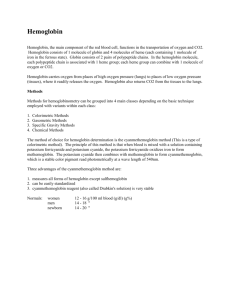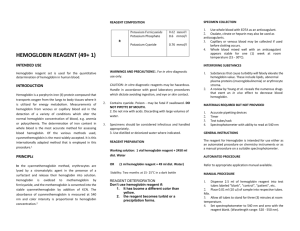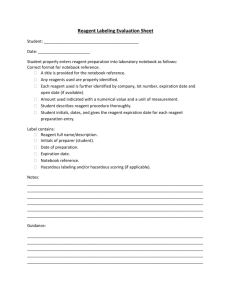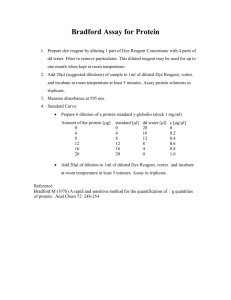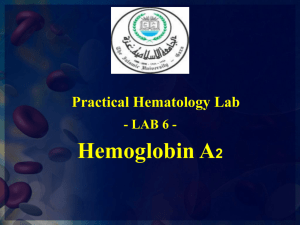Intended Use
advertisement
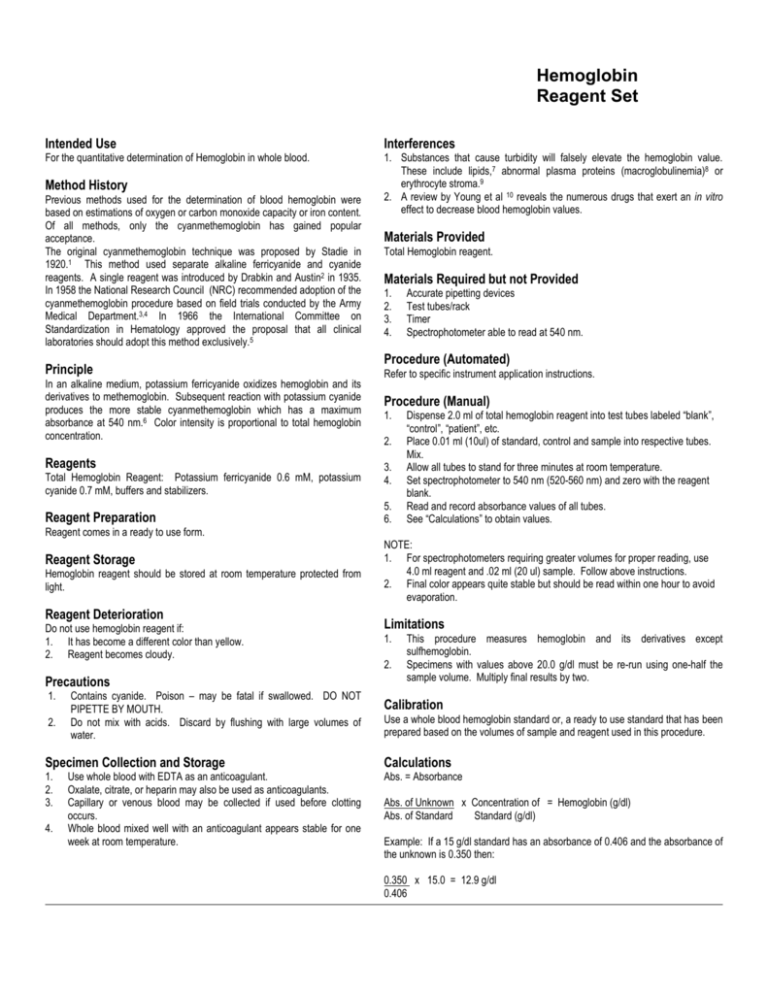
Hemoglobin Reagent Set Intended Use Interferences For the quantitative determination of Hemoglobin in whole blood. 1. Substances that cause turbidity will falsely elevate the hemoglobin value. These include lipids,7 abnormal plasma proteins (macroglobulinemia)8 or erythrocyte stroma.9 2. A review by Young et al 10 reveals the numerous drugs that exert an in vitro effect to decrease blood hemoglobin values. Method History Previous methods used for the determination of blood hemoglobin were based on estimations of oxygen or carbon monoxide capacity or iron content. Of all methods, only the cyanmethemoglobin has gained popular acceptance. The original cyanmethemoglobin technique was proposed by Stadie in 1920.1 This method used separate alkaline ferricyanide and cyanide reagents. A single reagent was introduced by Drabkin and Austin2 in 1935. In 1958 the National Research Council (NRC) recommended adoption of the cyanmethemoglobin procedure based on field trials conducted by the Army Medical Department.3,4 In 1966 the International Committee on Standardization in Hematology approved the proposal that all clinical laboratories should adopt this method exclusively.5 Principle In an alkaline medium, potassium ferricyanide oxidizes hemoglobin and its derivatives to methemoglobin. Subsequent reaction with potassium cyanide produces the more stable cyanmethemoglobin which has a maximum absorbance at 540 nm.6 Color intensity is proportional to total hemoglobin concentration. Reagents Total Hemoglobin Reagent: Potassium ferricyanide 0.6 mM, potassium cyanide 0.7 mM, buffers and stabilizers. Reagent Preparation Materials Provided Total Hemoglobin reagent. Materials Required but not Provided 1. 2. 3. 4. Accurate pipetting devices Test tubes/rack Timer Spectrophotometer able to read at 540 nm. Procedure (Automated) Refer to specific instrument application instructions. Procedure (Manual) 1. 2. 3. 4. 5. 6. Dispense 2.0 ml of total hemoglobin reagent into test tubes labeled “blank”, “control”, “patient”, etc. Place 0.01 ml (10ul) of standard, control and sample into respective tubes. Mix. Allow all tubes to stand for three minutes at room temperature. Set spectrophotometer to 540 nm (520-560 nm) and zero with the reagent blank. Read and record absorbance values of all tubes. See “Calculations” to obtain values. Reagent comes in a ready to use form. Reagent Storage Hemoglobin reagent should be stored at room temperature protected from light. Reagent Deterioration Do not use hemoglobin reagent if: 1. It has become a different color than yellow. 2. Reagent becomes cloudy. Precautions 1. 2. Contains cyanide. Poison – may be fatal if swallowed. DO NOT PIPETTE BY MOUTH. Do not mix with acids. Discard by flushing with large volumes of water. NOTE: 1. For spectrophotometers requiring greater volumes for proper reading, use 4.0 ml reagent and .02 ml (20 ul) sample. Follow above instructions. 2. Final color appears quite stable but should be read within one hour to avoid evaporation. Limitations 1. 2. This procedure measures hemoglobin and its derivatives except sulfhemoglobin. Specimens with values above 20.0 g/dl must be re-run using one-half the sample volume. Multiply final results by two. Calibration Use a whole blood hemoglobin standard or, a ready to use standard that has been prepared based on the volumes of sample and reagent used in this procedure. Specimen Collection and Storage Calculations 1. 2. 3. Abs. = Absorbance 4. Use whole blood with EDTA as an anticoagulant. Oxalate, citrate, or heparin may also be used as anticoagulants. Capillary or venous blood may be collected if used before clotting occurs. Whole blood mixed well with an anticoagulant appears stable for one week at room temperature. Abs. of Unknown x Concentration of = Hemoglobin (g/dl) Abs. of Standard Standard (g/dl) Example: If a 15 g/dl standard has an absorbance of 0.406 and the absorbance of the unknown is 0.350 then: 0.350 x 15.0 = 12.9 g/dl 0.406 Hemoglobin Reagent Set Quality Control The integrity of the reaction should be monitored by use of control material (normal/abnormal) with known hemoglobin concentrations. Expected Values 11,7 Adult Males: Adult Females: Children: Newborns: 13.0-18.0 g/dl 11.0-16.0 g/dl 10.0-14.0 g/dl 14.0-23.0 g/dl Factors such as age, race, exercise, season and altitude are reported to influence the values of normal ranges. The above range should serve only as a guideline. Each laboratory should establish its own range. Performance 1. 2. 3. Linearity: 20.0 g/dl Comparison: Studies conducted against a similar procedure yielded a coefficient of correlation of 0.992 with a regression equation of y=0.985x + .098 on samples with values from 8.7 to 18.2 g/dl (n=27) Precision: Assays (n=25) of hemoglobin control material yielded a coefficient of variation of 1.1% at 8.9 g/dl and 1.4% at 12.6 g/dl. References 1. 2. 3. 4. 5. 6. Stadie, W.C., J. Biol. Chem., 41:237, (1920) Drabkin, D.L., Austin, J.H., J. Biol. Chem., 112:51, (1935). Crosby, W.H., et al, U.S. Armed Forces Med J., 5:693, (1954). Crosby, W.H., et al, Blood, 12:1132, (1957). Eilers, R.J., Am. J. Clin. Pathol., 47:212, (1967). Tietz, N.W., Fundamentals of Clinical Chemistry, 2nd ed., W.B. Saunders Co., Philadelphia, p.411, (1976). 7. Henry, R.F., et al, Principles and Technics in Clinical Chemistry, 2nd Ed., Harper & Row, Hagerstown, MD, pp. 1128:1135, (1974). 8. Green, P., et al, Am. J. Clin. Path., 32:216, (1959). 9. Van Kampen, E.J., et al, Clin. Chem. Acta, 6:538, (1961). 10. Young, D.S., et al, Clin. Chem., 21:1D, (1975). 11. Wolf, P.L., Practical Clinical Hematology, John Wiley & Sons, NY, p. 144, (1973). Rev. 1/02 P803-H7504-01

